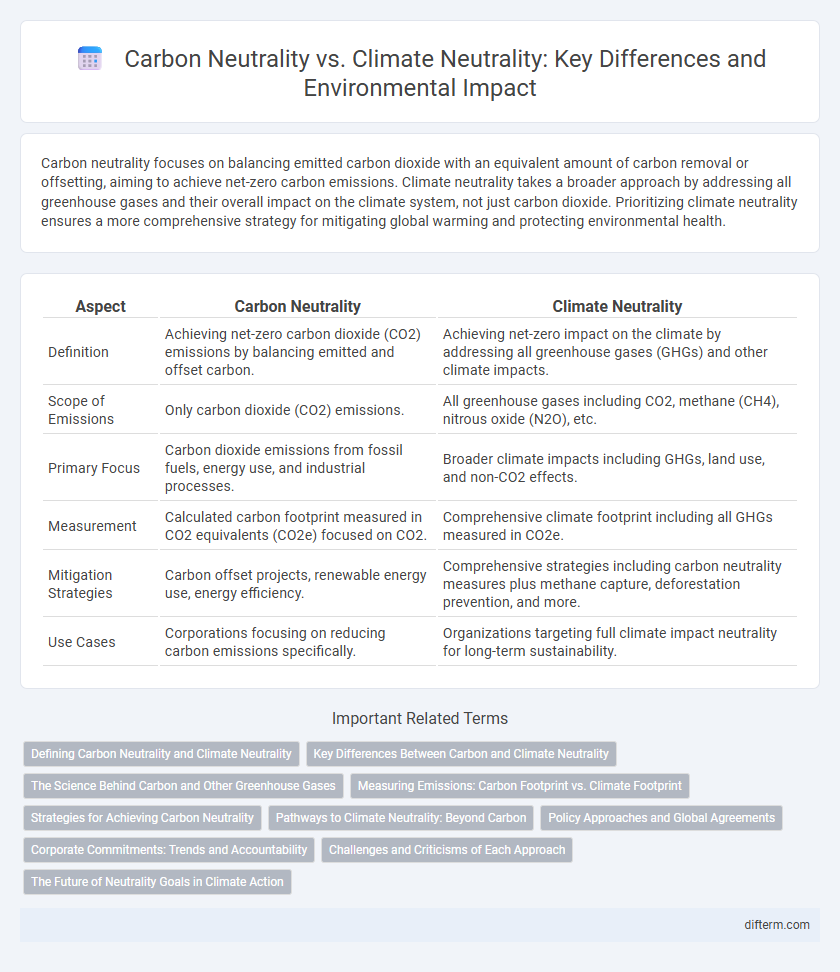Carbon neutrality focuses on balancing emitted carbon dioxide with an equivalent amount of carbon removal or offsetting, aiming to achieve net-zero carbon emissions. Climate neutrality takes a broader approach by addressing all greenhouse gases and their overall impact on the climate system, not just carbon dioxide. Prioritizing climate neutrality ensures a more comprehensive strategy for mitigating global warming and protecting environmental health.
Table of Comparison
| Aspect | Carbon Neutrality | Climate Neutrality |
|---|---|---|
| Definition | Achieving net-zero carbon dioxide (CO2) emissions by balancing emitted and offset carbon. | Achieving net-zero impact on the climate by addressing all greenhouse gases (GHGs) and other climate impacts. |
| Scope of Emissions | Only carbon dioxide (CO2) emissions. | All greenhouse gases including CO2, methane (CH4), nitrous oxide (N2O), etc. |
| Primary Focus | Carbon dioxide emissions from fossil fuels, energy use, and industrial processes. | Broader climate impacts including GHGs, land use, and non-CO2 effects. |
| Measurement | Calculated carbon footprint measured in CO2 equivalents (CO2e) focused on CO2. | Comprehensive climate footprint including all GHGs measured in CO2e. |
| Mitigation Strategies | Carbon offset projects, renewable energy use, energy efficiency. | Comprehensive strategies including carbon neutrality measures plus methane capture, deforestation prevention, and more. |
| Use Cases | Corporations focusing on reducing carbon emissions specifically. | Organizations targeting full climate impact neutrality for long-term sustainability. |
Defining Carbon Neutrality and Climate Neutrality
Carbon neutrality refers to balancing emitted carbon dioxide with an equivalent amount sequestered or offset, aiming for net-zero carbon emissions specifically. Climate neutrality encompasses a broader scope, targeting the net-zero impact of all greenhouse gases--including methane, nitrous oxide, and fluorinated gases--on the climate system. Both concepts are essential in environmental strategies to mitigate global warming but differ in their coverage of gases and overall climate impact.
Key Differences Between Carbon and Climate Neutrality
Carbon neutrality specifically targets balancing carbon dioxide emissions with equivalent carbon removal or offsetting efforts, focusing primarily on CO2 as a greenhouse gas. Climate neutrality adopts a broader approach by addressing all greenhouse gases, including methane and nitrous oxide, alongside carbon dioxide, aiming for a net-zero impact on the overall climate system. This distinction highlights that climate neutrality requires comprehensive strategies beyond carbon management to mitigate various contributors to global warming.
The Science Behind Carbon and Other Greenhouse Gases
Carbon neutrality targets balancing emitted carbon dioxide through reduction and offset initiatives, while climate neutrality encompasses all greenhouse gases including methane, nitrous oxide, and fluorinated gases. Scientific research highlights that while CO2 is the most abundant and long-lived greenhouse gas, methane has a significantly higher global warming potential over a shorter timeframe, necessitating broader climate neutrality efforts. Understanding the radiative forcing and atmospheric lifetimes of various gases is crucial for developing effective policies to mitigate global warming and achieve sustainable environmental goals.
Measuring Emissions: Carbon Footprint vs. Climate Footprint
Measuring emissions involves understanding the carbon footprint, which quantifies greenhouse gases like CO2 and methane directly linked to carbon. Climate footprint extends beyond carbon to include all climate-relevant substances such as nitrous oxide and fluorinated gases, offering a broader measure for climate neutrality. Accurate assessment of both footprints is crucial for setting effective targets and tracking progress toward sustainability goals.
Strategies for Achieving Carbon Neutrality
Strategies for achieving carbon neutrality emphasize reducing greenhouse gas emissions through renewable energy adoption, energy efficiency improvements, and carbon offset initiatives like reforestation. Companies and governments implement carbon accounting frameworks to monitor and verify emission reductions, ensuring transparency and accountability. Investing in carbon capture technologies and promoting sustainable practices across supply chains also play critical roles in reaching true carbon neutrality.
Pathways to Climate Neutrality: Beyond Carbon
Pathways to climate neutrality extend beyond carbon neutrality by addressing all greenhouse gas emissions, including methane, nitrous oxide, and fluorinated gases. Achieving climate neutrality involves integrated strategies such as energy transition to renewables, carbon capture and storage, sustainable land use, and enhanced methane management. This holistic approach ensures comprehensive mitigation of climate impacts rather than focusing solely on carbon dioxide emissions.
Policy Approaches and Global Agreements
Policy approaches to carbon neutrality emphasize reducing carbon dioxide emissions through targeted regulations and carbon pricing mechanisms, while climate neutrality strategies broaden the scope to include all greenhouse gases and carbon sinks. International agreements such as the Paris Agreement promote climate neutrality by setting nationally determined contributions (NDCs) that address comprehensive emission reductions and carbon capture efforts. Effective global collaboration requires integrating carbon neutrality goals within broader climate neutrality frameworks to ensure holistic environmental sustainability and compliance with global climate targets.
Corporate Commitments: Trends and Accountability
Corporate commitments to carbon neutrality emphasize reducing greenhouse gas emissions solely from carbon dioxide, whereas climate neutrality encompasses a broader spectrum of greenhouse gases and environmental impacts. Leading corporations increasingly set climate neutrality goals to address full environmental footprints, integrating methane, nitrous oxide, and adaptation measures into sustainability strategies. Transparent reporting frameworks and third-party verifications bolster accountability, reflecting growing stakeholder demand for comprehensive climate action beyond carbon alone.
Challenges and Criticisms of Each Approach
Carbon neutrality faces challenges such as reliance on carbon offset projects that may lack transparency or permanence, raising concerns about effectiveness and accountability. Climate neutrality, while more comprehensive by targeting all greenhouse gases and climate impacts, encounters difficulties in measurement and implementation due to complex global emission sources and varying national policies. Both approaches are criticized for potentially enabling carbon-intensive industries to delay substantial emission reductions by depending heavily on offsets or unproven technologies.
The Future of Neutrality Goals in Climate Action
Carbon neutrality targets focus on balancing carbon dioxide emissions with carbon removal or offsetting measures to achieve net-zero carbon footprints. Climate neutrality expands this goal by addressing all greenhouse gas emissions, including methane and nitrous oxide, aiming for net-zero impact on global warming. Future neutrality goals will likely emphasize integrated strategies combining carbon and climate neutrality, leveraging advanced technologies and comprehensive policies to meet international climate agreements effectively.
carbon neutrality vs climate neutrality Infographic

 difterm.com
difterm.com